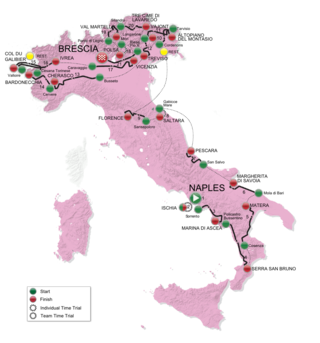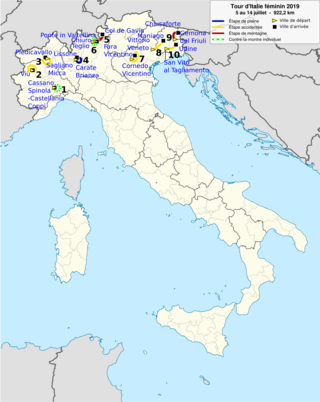Classification leadership
There were four different jerseys awarded in the 2009 Giro Donne. These followed the same format as those in the men's Giro d'Italia. The leader of the General classification received a pink jersey. This classification was calculated by adding the combined finishing times of the riders from each stage, and the overall winner of this classification is considered the winner of the Giro. [4]
Secondly, the points classification awarded the maglia ciclamino, or mauve jersey. Points were awarded for placements at stage finishes as well as at selected intermediate sprint points on the route, and the jersey would be received by the rider with the most overall points to their name. [4]
In addition to this, there was a mountains classification, which awarded a green jersey. Points were allocated for the first few riders over selected mountain passes on the route, with more difficult passes paying more points, and the jersey would be received by the rider with the most overall points to their name. [4]
Finally, there was the jersey for the Best Young Rider, which was granted to the highest-placed rider on the General classification aged 23 or under. This rider would receive a white jersey.

The Giro d'Italia is an annual multiple-stage bicycle race primarily held in Italy, while also starting in, or passing through, other countries. The first race was organized in 1909 to increase sales of the newspaper La Gazzetta dello Sport, and the race is still run by a subsidiary of that paper's owner. The race has been held annually since its first edition in 1909, except during the two world wars. As the Giro gained prominence and popularity the race was lengthened, and the peloton expanded from primarily Italian participation to riders from all over the world. The Giro is a UCI World Tour event, which means that the teams that compete in the race are mostly UCI WorldTeams, with some additional teams invited as 'wild cards'.

The Giro Donne is an annual women's cycle stage race around Italy. First held in 1988, the race is currently part of the UCI Women's World Tour, and is currently organised by Starlight / PMG Sport. The race was previously branded as the Giro d'Italia Femminile prior to 2013, and the Giro Rosa from 2013 to 2020.
The 2001 Giro d'Italia was the 84th edition of the Giro. It began with a 7 km (4 mi) prologue that went from Montesilvano to Pescara. The race came to a close on June 10 with a mass-start stage that ended in the Italian city of Milan. Twenty teams entered the race that was won by the Italian Gilberto Simoni of the Lampre–Daikin team. Second and third were the Spanish riders Abraham Olano and Unai Osa.
The 2000 Giro d'Italia was the 83rd edition of the Giro. It began with a 4.6 km (3 mi) prologue that navigated through the Italian capital Rome. The race came to a close on June 4 with a mass-start stage that ended in the Italian city of Milan. Twenty teams entered the race that was won by the Italian Stefano Garzelli of the Mercatone Uno–Albacom team. Second and third were the Italian riders Francesco Casagrande and Gilberto Simoni.

The 2008 Giro d'Italia was the 91st running of the Giro d'Italia, one of cycling's Grand Tours. It began in Palermo on 10 May and ended in Milan on 1 June. Twenty-two teams entered the race, which was won by Spaniard Alberto Contador of the Astana cycling team. Second and third respectively were Italians Riccardo Riccò and Marzio Bruseghin.

The 2009 Giro d'Italia was the 92nd running of the Giro d'Italia, one of cycling's Grand Tours. It was held from 9 to 31 May 2009, and marked the 100th year since the first edition of the race. Starting in Venice and finishing in Rome, 22 teams competed over 21 stages. Four of the top ten finishers in this edition later had their results voided.

The 2010 Giro d'Italia was the 93rd edition of the Giro d'Italia, one of cycling's Grand Tours. The race started off in Amsterdam on 8 May and stayed in the Netherlands for three stages, before leaving the country. The route included climbs such as Monte Zoncolan, Plan de Corones, the Passo del Mortirolo and the Passo di Gavia before ending in Verona with an individual time trial.

The 2011 Giro d'Italia was the 94th Giro d'Italia, one of cycling's Grand Tours. The race started on 7 May with a team time trial in Turin to celebrate the 150th anniversary of Italian unification, when the city served as the first capital of the single state.
The 2010 Giro d'Italia Femminile or 2010 Giro Donne was the 21st running of the Giro d'Italia Femminile, one of the premier events of the women's road cycling calendar. It was held over ten stages from 2–11 July 2010, starting in Muggia and finishing in Monza. It was won by Mara Abbott of USA National Team, the first American ever to win the Giro Donne.

The 2012 Giro d'Italia was the 95th edition of Giro d'Italia, one of cycling's Grand Tours. It started in the Danish city of Herning, and ended in Milan. The complete route of the 2012 Giro d'Italia was announced in mid October. For the first time since the 2007 edition no climbing time trial was included in the route. The colour of the jersey for the mountains classification was changed for this year's edition from green to blue. The move came at the behest of sponsor Banca Mediolanum, who renewed its support of the mountains classification for a further four years.
The 2012 Giro d'Italia Femminile, or Giro Donne, was the 23rd running of the Giro d'Italia Femminile, the most prestigious stage race on the women's road cycling calendar. It was held over nine stages from 29 June to 7 July 2012, starting in Naples and finishing in Bergamo. The race was won by last year's winner Marianne Vos, who also won 5 of the 9 stages as well as the yellow jersey (points).
The 2011 Giro d'Italia Femminile, or Giro Donne, was the 22nd running of the Giro d'Italia Femminile. It was held over ten stages from 1 to 10 July 2012, starting in Rome and finishing with an individual time trial in San Francesco al Campo near Turin.

The 2013 Giro d'Italia was the 96th edition of the Giro d'Italia, one of cycling's Grand Tours. It started in Naples and finished in Brescia. Vincenzo Nibali of team Astana won the general classification.

The 2017 Giro d'Italia was the 100th edition of the Giro d'Italia, one of cycling's Grand Tour races. The race started on 5 May in Alghero on the island of Sardinia, and ended on 28 May in Milan. The race was won by Tom Dumoulin, who became the first Dutch male winner of the Giro.

The 2017 Giro d'Italia Femminile, or 2017 Giro Rosa, was the 28th running of the Giro d'Italia Femminile, the only remaining women's Grand Tour. It was held between 30 June and 9 July 2017 as the most prestigious stage race of both the 2017 UCI Women's World Tour and the women's calendar.
The Giro Donne has been won three times by a racer who led the general classification on the first stage and held the lead all the way to finish. Catherine Marsal was the first to accomplish this achievement in the 1990 Giro, with Fabiana Luperini and Nicole Brändli doing the same in 1996 and 2005 respectively.

The 29th running of the women's Giro d'Italia, or Giro Rosa, was held from 6 to 15 July 2018. Raced over ten stages, it is considered the most prestigious stage race of the women's calendar. It was the 14th event of the 2018 UCI Women's World Tour. Two-time winner Anna van der Breggen was the defending champion. However she elected not to defend her title, choosing instead to focus on preparing for a bid to win her first title at the Road World Championships.

The 30th women's Giro d'Italia, or Giro Rosa, was held from 5 to 14 July 2019. Raced over ten stages, it was considered the most prestigious stage race of the women's calendar. The defending champion, Annemiek van Vleuten, won the race.

The 31st women's Giro d'Italia, or Giro Rosa, was held from 11 to 19 September 2020. It is considered the most prestigious stage race of the women's calendar and of the 2020 UCI Women's World Tour. The race was originally scheduled from 26 June to 5 July, but was postponed to mid-September due to the COVID-19 pandemic in Italy and reduced to 9 stages rather than the originally planned 10.
The 2021 Giro d'Italia Donne was the 32nd edition of the Giro d'Italia Femminile women's road cycling stage race. The race started on 2 July and finished on 9 July and, as the longest and one of the most prestigious races on the women's calendar, included ten stages covering over 1,000 kilometres (620 mi) across northern Italy.












